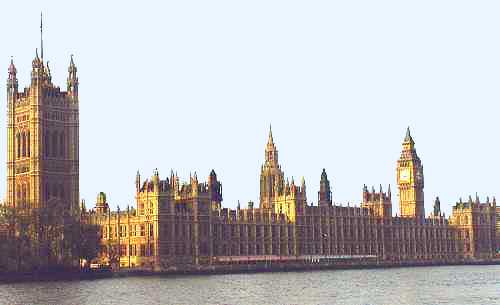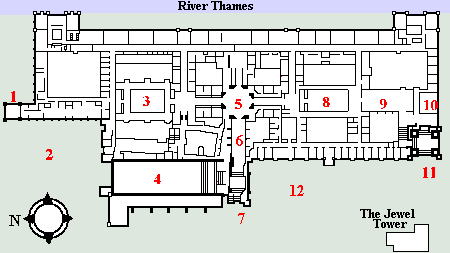| London Town Guide |
The Houses of Parliament and Big Ben
(Palace of Westminster)
Parliament Square, SW1
Tel: 020 7219 4272 (House of Commons information)
Tel: 020 7219 3107 (House of Lords information)
Nearest Tube: Westminster

The building that you see today actually only dates from the 1840s - it was designed by Charles Barry and Augustus Pugin after most of the first Houses of Parliament burned down in 1834. But the history of the site dates back much further....
Edward the Confessor built the Palace of Westminster on the site in 1049 and the first Parliament was held there in 1275. Westminster then became the permanent home of Parliament after Henry VIII (1509-47) chose to live in Whitehall in 1532.
|
|
You enter the Houses of Parliament through St Stephen's Porch (7) and then pass into St Stephen's Hall (6). This hall is a replica of the original chapel built by Edward I (1272-1307) which is where the House of Commons met until 1834. The hall then leads to the Central Lobby (5).
The massive Westminster Hall (4) is to the left of St Stephen's Hall. It dates back over 900 years and measures a vast 240ft by 60ft. The oak hammerbeam roof dates from the 14th century and is considered by many to be one of the best preserved medieval achievements. You can only go into the hall as part of a guided tour, but you can glimpse it from St Stephen's Porch (7).
| If you visit the House of Commons (4), the most obvious thing you will notice is that the Members of Parliament sit facing each other. This tradition dates back to the days when the Commons sat facing each other in the choirstalls of Edward I's chapel. You will also notice two red lines separating the two sides. These are there to make sure that debates don't turn into fights and, in a tradition that dates back hundreds of years, are exactly two sword widths apart. During a debate MPs must stay behind their line which is where the expression 'toeing the party line' comes from. The House of Lords (8) is also worth seeing as it has a much more splendid interior than the House of Commons. If you visit either the House of Commons or the House of Lords you will be given a guide sheet which will expain the many baffling procedures that you will probably witness. The most famous part of the Houses of Parliament is the clock tower which is officially known as St Stephen's Tower, but which is more commonly nicknamed 'Big Ben' (1). The nickname actually refers specifically to the giant 13-ton main bell that rings out every hour. It is thought that the name comes from Sir Benjamin Hall who was Commissioner of Works when the bell was first installed in 1858, although it has also been claimed that it was named after the popular boxer of the time Benjamin Caunt. |
 |
A visit to the Jewel Tower should tell you everything you need to know about the Houses of Parliament, but if you do want to go on a guided tour, you should contact either your local MP or your country's embassy who should be able to arrange a place for you.
 | ||||||||||||||||||||||||
|
|
Copyright © 1995 to 2016 Smooth Hound Systems
Smooth Hound Systems accepts no liability with regards to the accuracy of the information on this site.
Users are advised to double check information such as dates, times, prices etc.
